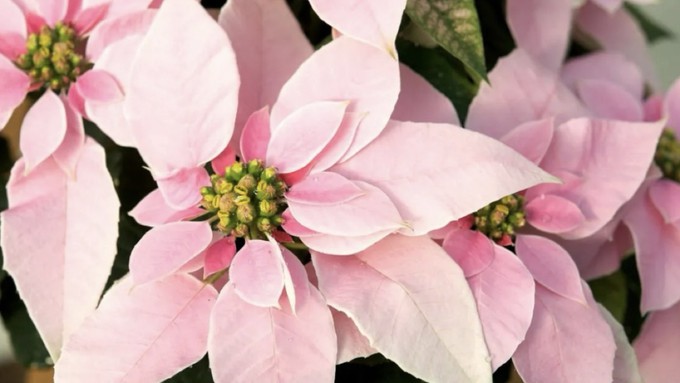
Popular holiday plant comes in wide range of hues including several shades of pink

Whether pink or white or red -- or some combination -- poinsettias like warmth (but not too much). Courtesy Princettia
Red flowers may be traditional for the holidays, but this eye-popping color makes people say wow.
It seems apropos that in the year of “Barbie” the hottest-selling poinsettia hue this season is pink.
Poinsettias already come in practically every shade of red, from brightest crimson to deepest burgundy. Selective breeding widened their spectrum from pure white and butter yellow to variegated combinations.
Improvements in pink poinsettias have pushed these holiday blooms to the forefront. They’ve also pushed up poinsettia season to as early as October – Breast Cancer Awareness Month.
In fact, some varieties of pink poinsettias have become popular fundraisers for breast cancer charities and are now marketed for October events as well as in December for holiday gifts.
Poinsettias – a euphorbia native to Southern California and Mexico – were originally all red. Today’s best pinks were mostly developed in Europe and are now sold under the brand name Princettia.
“Princettia is a brand of interspecific hybrid euphorbias that have traits that improve upon the traditional poinsettia,” says Nursery Management magazine. “In addition to vibrant, unique colors, Princettia plants have a compact habit with branching that creates more flower clusters with smaller bracts, like a centerpiece. They offer extended shelf life at retail and are more heat tolerant and durable in landscapes.”
These pinks range from palest baby pink to vibrant almost-neon hot pink. Barbie would approve.
No matter their color, poinsettias all require the same care to last their longest.
If you want to keep that poinsettia looking its best, keep it indoors out of the cold, wind and rain. If poinsettias feel a chill, they drop their leaves.
Native to temperate coastal areas with winters in the 70s, poinsettias can be finicky. They can’t take too much cold or heat, preferring temperatures between 60 and 75 degrees.
To get the most out of your poinsettia and to keep it looking good into the new year, follow these tips:
* Purchase a poinsettia with dark green leaves all the way to the soil line; it still has all its foliage. That’s a good sign of freshness; skip plants with yellowed or many missing leaves. Avoid any that look wilted, dried out or overly wet.
* Look at the actual flowers – the little nubs in the center of the bloom. The flowers should be green or red and look fresh. If already yellow and covered with pollen, those flowers mean the poinsettia’s days are numbered.
* Take off the foil or paper wrapping; it traps too much water around the roots. Poinsettias need good drainage and don’t like standing in water. Put a saucer under the pot and, after watering, drain any excess.
* Treat poinsettias like Goldilocks; they want it just right. Exposure to temperatures below 50 degrees, even for a few minutes, can cause leaf drop. Consider that before creating outdoor displays; they’ll last one night.
* Inside, find a spot with indirect light for six hours a day, away from drafts or forced heat. Poinsettias like days in the 60s; slightly cooler (55 degrees) and dark at night.
* Poinsettias prefer soil on the dry side, but don’t let it completely dry out. Feel the soil daily and water when needed.
* After bloom, poinsettias can be fed a balanced liquid fertilizer to prompt new growth. If kept comfortable, they may rebloom next year.
Comments
0 comments have been posted.Sacramento Digs Gardening to your inbox.
Sites We Like
Garden Checklist for week of Oct. 27
It's still great weather for gardening. Grab a sweater – and an umbrella, just in case – then get to work:
* October is the best month to plant trees, shrubs and perennials.
* Harvest pumpkins and winter squash.
* Pick apples and persimmons. Remember to pick up fallen fruit, too; it attracts pests.
* Clean up the summer vegetable garden and compost disease-free foliage.
* Dig up corms and tubers of gladioli, dahlias and tuberous begonias after the foliage dies. Clean and store in a cool, dry place.
* Treat azaleas, gardenias and camellias with chelated iron if leaves are yellowing between the veins.
* Now is the time to plant seeds for many flowers directly into the garden, including cornflower, nasturtium, nigella, poppy, portulaca, sweet pea and stock.
* Plant seeds for radishes, bok choy, mustard, spinach and peas.
* Plant garlic and onions.
* Set out cool-weather bedding plants, including calendula, pansy, snapdragon, primrose and viola.
* Reseed and feed the lawn. Work on bare spots.